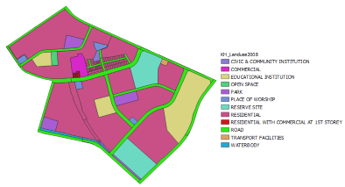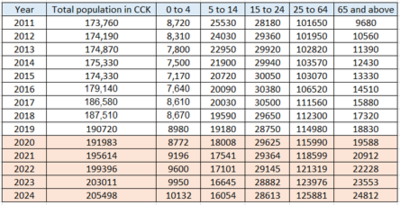G2-Group03 Final Report
Contents
Introduction
Choa Chu Kang is a planning area and residential town located at the north-westernmost point of the West Region of Singapore. The name "Choa Chu Kang" is derived from the Teochew word "kang chu". In the nineteenth century, Chinese immigrants to plant gambier and pepper along the river banks of Choa Chu Kang, although many migrated to Johor to the north at the encouragement of Temenggong, Johor. The plantation owners were known as Kangchu - the word "kang" refers to the riverbank and "chu" means "owner" or "master", referring to the headman in charge of the plantations in the area. "Choa" is the clan name of the first headman. Choa Chu Kang has a total area of 6.11 km2. As of the Master Plan 2014, Choa Chu Kang planning area is made up of 6 subzones: Choa Chu Kang Central, Choa Chu Kang North, Keat Hong, Peng Siang, Teck Whye and Yew Tee. It has a total population of 190,720 (as of June 2019) and population density of 31,265km2.
Objectives
1. Determine if current amenities and facilities will be able to meet the needs of the projected population of Choa Chu Kang in 2024, especially that of the infants (ages 0 to 4), working population (ages 25 to 64) and elderly (ages 65 and above).
2. Determine and select ideal locations in Choa Chu Kang for future amenities to be built to meet the needs of the aforementioned age groups.
Areas of Reseach
Education
The Singaporean government consistently places a large emphasis on education. Every young Singaporean is given multiple opportunities to further their studies in their areas of interest. Hence, education institutions in Singapore are strategically placed such that the majority of the population has access to these institutions. In Choa Chu Kang, there are multiple educational institutions that cater to the needs of the various age groups.
Healthcare Facilities
As the population of elderly residents in Singapore is expected to increase, there has been an increase in the number of healthcare facilities for the elderly throughout the island. As urban planners, we will be analysing the ratio of healthcare facilities to the population of elderly residents in Choa Chu Kang to determine if the current number of facilities available are able to meet their needs.
Transport
There are various transportation facilities within the Choa Chu Kang planning area, namely Choa Chu Kang MRT station, Yew Tee MRT station, Choa Chu Kang Bus Interchange and Bukit Panjang LRT system. These facilities provide ease of access for commuters to travel within Choa Chu Kang and from Choa Chu Kang to the Central and Downtown area of Singapore. Furthermore, the Bukit Panjang LRT system provides residents with convenient access to the town centre and to the nearby town of Bukit Panjang.
Task 1 Change Detection
What are the changes between Master Plan 2008 and Master Plan 2014?
| Year 2008 | Year 2014 |
|---|---|
In Master Plan 2008, Choa Chu Kang has 7 subzones: Yew Tee, Kranji North, Pang Sua, Central, Peng Siang, Keat Hong, Teck Whye.
In Master Plan 2014, Choa Chu Kang consists of 6 subzones: Yew Tee, Choa Chu Kang North, Choa Chu Kang Central, Peng Siang, Keat Hong, Teck Whye.
Overlay of Choa Chu Kang 2008 and 2014
Transformation Matrix of 2008 against 2014
Residential area analysis 2014
From Master Plan 2008 to 2014, about 67664.14m2 of Reserve site was converted to Residential land use. Both Park and Educational Institution land use area has decreased to make way for more Residential land use at 12505.55m2 and 17934.52m2 respectively. The residential land use in 2008 has also decreased by 51917.51m2 for Road land use and 22238.27m2 for Park land use. Overall, there is still a net land gain of 23948.42m2 for Residential area in 2014.
Road area analysis 2014
From Master Plan 2008 to 2014, we can clearly identify that the residential area and park area in 2008 has reduced in 2014 to build more roads. Road land use has gained a total of 13803.31m2 from Parks and 51917.51m2 from Residential area. There was no land loss for roads amenities from 2008 to 2014.
Park area analysis 2014
From Master Plan 2008 to 2014, there was a net decrease in land use area for Parks. Despite gaining 22238.27m2 from Residential land use in 2014, Park land use area decreased by 13803.31m2 for Road land use and 12505.54m2 for Residential land use in 2014. Therefore, there is a total loss of 4070.58m2 for Park land use.
Education area analysis 2014
From Master Plan 2008 to 2014, there was a net land gain area for educational area. Despite a decrease of 17934.52m2 to Residential, they also gained 21850.26m2 from Residential area. Therefore, Education area has increased by 3915.73m2. This land use area gained for Educational purposes can be found in subzone Keat Hong.
Health and Medical care 2014
From Master Plan 2008 to 2014, the Health and Medical Care land use area increased by 48068.70m2. It was a net gain as there was no land loss from the Health and Medical Care area. This is the second biggest land gained from Reserve Site after Residential area. This major land gain can be found in subzone Keat Hong.
Subzone Area Change from Year 2008 to Year 2014
| A: Yew Tee | |
| Year 2008 |
Year 2014 |
Comparison Analysis:
In the 2008 Master Plan, a section of reserved site with an area of 7182.69m2 has been transformed into a residential area by 2014. Furthermore, the Transport Facilities land use area in 2008 with an area of 2376.75m2 has been entirely converted into Park land use in 2014. | |
| B: Choa Chu Kang North | |
| B: Year 2008 - Kranji North |
B: Year 2008 - Pang Sua |
| B: Year 2014 - Choa Chu Kang North | |
Comparison Analysis:
In 2008 Master Plan, CCK North did not exist. The area was split into 2 smaller subzones - Kranji North and Pang Sua. From 2008 to 2014, there was no change in Kranji North land use. In 2014, the two subzones were combined to form Choa Chu Kang North which has an area of 1428268.59m2. 1690m2 of Park land use in Pang Sua was converted to widen the Roads network in 2014. The reserve site area has also given up 1106m2 of land to widen the only road to the expressway. | |
| C: Choa Chu Kang Central | |
| C: Year 2008 |
C: Year 2014 |
Comparison Analysis:
According to the 2008 Master Plan, Civic & Community Institution land use with an area of 5740.24m2 has been completely converted into Park land use in 2014. However, a section of the Park area in 2008 has also been converted into 4835.46m2 of Civic & Community Institution land use. In conclusion, Civic & Community land use area only has a net loss of 904.58m2. | |
| D: Peng Siang | |
| D: Year 2008 |
D: Year 2014 |
Comparison Analysis:
In the 2008 Master Plan, there is one Place of Worship with an area of 2021.57m2 which was converted into residential area in 2014. In 2008, there was only 1 utility area with an area of 8589.62m2. In 2014, 6538.44m2 of residential area was converted into utility area. Additionally, the largest increase in land use in Peng Siang is the Road landuse. It increased by a total of 534737.07m2 from 2008 to 2014.Lastly, in 2008, 3256.33m2 of Civic & Community Institution land use area was entirely converted into a reserve site in 2014. The 2014 total reserve site area is 9516.13m2. | |
| E: Teck Whye | |
| E: Year 2008 |
E: Year 2014 |
Comparison Analysis:
From 2008 to 2014, there was a total decrease of 20390.81m2 from Reserve Site. Road landuse experienced a net land gain of 152809.96m2 from the reserve site. For Special Use land use area, it decreased by 3843.09m2 from 2008 to 2014. In addition, the residential area has a net increase in land use area of 139180.26m2. | |
| F: Keat Hong | |
| D: Year 2008 |
D: Year 2014 |
Comparison Analysis:
In the Master Plan 2008, there was 660214.81m2 of Residential area. The southernmost area of Reserve site has been converted into 63046.51m2 worth of Health & Medical Care Area. Above the Medical care area, there is a newly built Civic & Community Institution that was converted from 7061m2 of Residential area. In 2014, the Educational Institution above the Civic & Community Institution has taken over the previous Park land use area from 2008. Overall, there was a large increase in land use area for Educational Institution by 12120m2. Residential land use area has also increased by 33853m2 worth of land in 2014.Lastly, the place of worship has a net land gain of 2001m2 from the residential area. The place of worship is widely spread around the Keat Hong subzone. | |
Task 2 Population projection till 2024
In order to get the projected population numbers for every year up till 2024, we used an Excel function, FORECAST.LINEAR(), to do a linear projection. This Excel function analyses the trends of the population in Choa Chu Kang from 2011 to 2019 and predicts future populations based on this trend. Total population numbers for each year is then plotted into a linear graph as shown below.
| Total Population Prediction in Choa Chu Kang | Data Analysis |
|---|---|
After applying the Excel function FORECAST.LINEAR() to the historical population data, it is predicted that Choa Chu Kang will have a total population of 205,498 in 2024. The population of young children (aged 0-4) is expected to increase by 15.5%, from 8772 in 2019 to 10132 in 2024. More than half (61%) of the total population in 2024 will be contributed by the working population (ages 25 to 64), while the elderly (ages 65 and above) will contribute to 12% of the total population in 2024. In order to get more representative numbers, we also made the assumption that the spread of young children aged 3-6 and elderly aged 65 and above are consistent throughout the entire Choa Chu Kang planning area.
Choa Chu Kang Central
The current population in Choa Chu Kang Central is 22,230. This number is expected to increase to 22,991 in 2024.
Choa Chu Kang North
Currently, Choa Chu Kang North has a population of 32,440 residents (2019). According to projection data, the population in this subzone is expected to drop to 31,304.
Keat Hong
This year, Keat Hong has a total population of 36,960. This number is expected to increase to 52,816 in 2024.
Peng Siang
Peng Siang has a population of 33,420 this year (2019). Our data projections predict that Peng Siang’s population will increase to 36,000.
Teck Whye
Currently, Teck Whye has a population of 24,720 residents. The population in this subzone is predicted to decrease to 23,129 in 2024.
Yew Tee
The current population of Yew Tee is 40,950 (2019). This number is predicted to decrease to 37,756 in 2024.




















